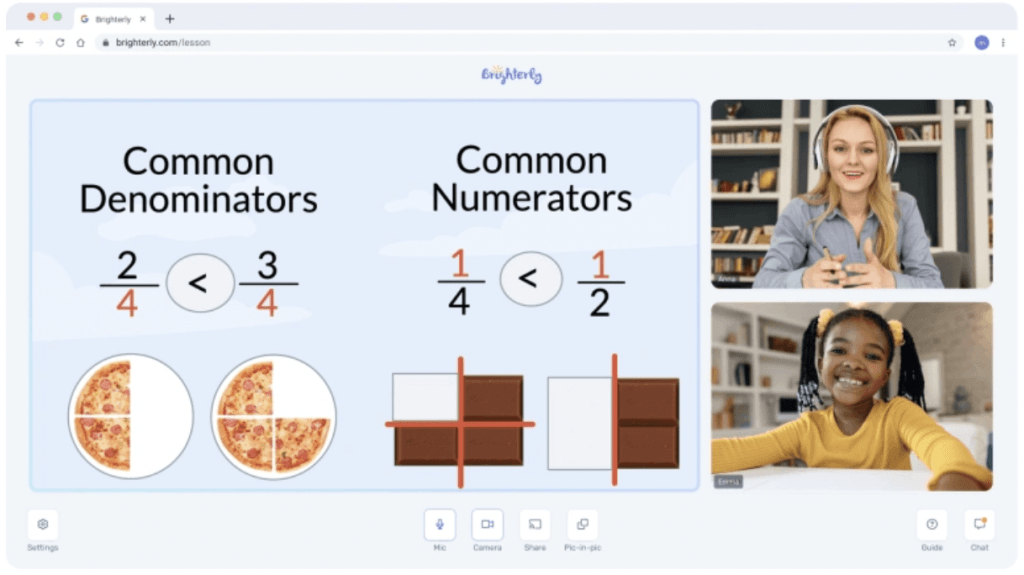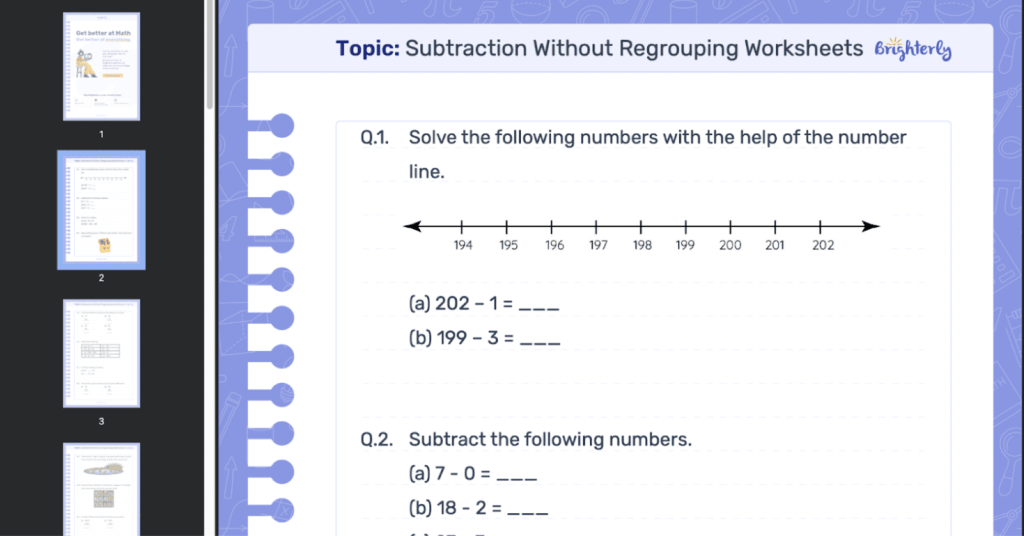How to Teach Math to Kids? 12 Best Ways
reviewed by Jo-ann Caballes
Updated on May 6, 2025
When learning math, some kids feel like math wizards. The others freeze in horror at the mere thought of it. The funny thing is, when parents begin to teach, both categories can struggle. I am a professional math tutor, and in this article, I’ll show you how to teach kids math in a way that builds confidence, keeps it fun, and actually sticks.
Key points
- I don’t recommend a one-size-fits-all approach to teaching math. To maximize your kids’ academic potential, it is essential to tailor your teaching to their unique learning style, pace, and interests.
- Math tutoring is one of the best ways to maximize your kid’s math potential.
- Adapting your teaching to follow your child’s learning style can significantly help with math comprehension.
12 strategies for teaching math at home
- Learning with math tutors
- Practicing with free math worksheets
- Using math in everyday life
- Playing math games
- Singing math songs
- Reading math books for children
- Using positive language
- Encouraging mental math
- Following the kids’ learning style
- Using visual representation
- Utilizing hands-on objects
- Setting a positive example
Note: There is no one-size-fits-all approach to teaching math. If you want to maximize your kids’ academic potential, it’s essential to tailor your teaching to their unique learning style, pace, and interests.
Let’s review 12 creative ways to teach mathematics in more detail and explore what may be the best combination for your child. 👇
#1. Helping your child learn math with math tutors
Best for: Students with learning differences, homeschooled kids, test prep, and reinforcing concepts learned in school.
Helping kids with math sounds fun and easy until you actually try. One of the most common complaints among children is that they dislike mathematics because it is too difficult. Sadly, most parents can share this complaint, too, as it’s almost impossible for them to teach kids math themselves. On top of that, not having proper resources or a solid support system, teaching elementary math becomes a daunting task.
As a professional math tutor, I believe the best way to teach math is through math tutoring. To effectively teach kids math, focus on having a trusted tutor. It can actually help alleviate math anxiety and learn without the pressure they often feel from their parents. Expert tutors possess the skill set to engage, motivate, and inspire kids to be proactive and interested in the math subject. Additionally, online math tutoring platforms provide resources and offer visual aids to cater to different learning styles and maximize children’s learning. One of these platforms is the Brighterly math tutoring platform.

Unlike many platforms on the market, Brighterly focuses on play-based teaching methods, rather than repetitive drills. The platform aims to be the number 1 result-driven and student-first tutoring service and uses the following strategies for teaching mathematics:
- Comprehensive US Common Core-aligned program
- Stress-free environment
- Hands-on, interactive math learning
- Age-appropriate examples
Furthermore, the platform’s tutors don’t employ “cure-all” approaches when teaching kids math. They systematically address issues and learning gaps, empowering students to ask questions, participate, and progress at their own pace. That is why, before assigning a tutor, Brighterly thoroughly diagnoses every kid’s current knowledge during a trial math class.
The platform has an affordable price from 17.40/lesson, which is quite price-effective compared to competitors. For example, the standard tutoring rate around the United States is between $20 and $80.
How can Brighterly math tutors help your child with math learning?
Personalized lessons
There are numerous ways to teach math, but personalized lessons are among the most effective methods. Brighterly specializes in interactive online math sessions, with a focus on creating a personalized program tailored to each student. The core principle of Brighterly’s tailored approach is to diagnose your child’s learning needs, make the sessions as engaging as possible, and show how math transfers to real-world scenarios.
Brighterly’s math curriculum utilizes the US Common Core standards and research-based teaching methods. It was developed (and is constantly being reviewed) by the platform’s best learning experts to ensure efficiency, math confidence, and a student-first approach.
Confidence building
When kids say “I hate math!” it is often not because math is hard, but rather how it makes them feel. This is why building confidence is a crucial pillar of math instruction. Brighterly tutors know how to infuse children with self-confidence by providing a calm, neutral environment where your child can relax, open up, and learn without fear of judgment.
To ensure great performance, the platform carefully selects each potential candidate and does a rigorous background check. Brighterly only accepts professional tutors with at least 3 years of experience who know how to teach kids mathematics to make them happy and confident.
Foundational strength
Brighterly’s primary focus is on building foundational strength for children in grades 1-9. Foundational strength in math means knowing how mathematical concepts work and, essentially, why children apply given concepts.
I believe the best way to teach kids math is through logic and reasoning rather than relying on tricks, shortcuts, or plain memorization. This is where Brighterly tutors use visual aids, real-world examples, and step-by-step reasoning to make abstract math concepts relatable and understandable.
In simple words, they know how to help your child learn math through:
- Breaking down problems into smaller steps
- Seeing the why behind formulas
- Using logic to solve unfamiliar problems
- Applying math to real-life scenarios
#2. Teaching kids math with FREE math worksheets
Best for: Children aged 6-15, homeschoolers, and children who prefer learning at their own pace.
If you ever wondered about how to teach math to kids at home, you probably considered math worksheets. Teaching elementary math with the help of the worksheets can be tough (especially if you didn’t have a math degree!). However, it is among the most effective ways to teach basic math for free. Addition, subtraction, multiplication, division, word problems, or whatever it may be, there are plenty of free PDF math worksheets available online.
How to teach math to kids with worksheets
- Build confidence through step-by-step problem-solving and critical thinking
- Reinforce basic concepts through repetition
- Teach math in a creative way
- Work independently and at their own pace
- And prep for standardized tests
You don’t have to be a teacher or have special knowledge to use worksheets effectively.
A 6-step guide on how to utilize worksheets
- Evaluate which skills your kid needs to reinforce.
- Download and print free worksheets.
- Set a timer depending on your kid’s age and attention span. Don’t forget to schedule breaks to avoid burnout!
- Help your child with any questions or issues — be patient, explain every step in a positive way.
- Review the answers together. Not just right or wrong, talk through the challenges, strengths, and overall result.
- Celebrate your kid’s effort! Tell them how proud you are — a positive attitude goes a long way.
Now, where do you find free PDF worksheets? Brighterly offers free, high-quality math worksheets to make your kid’s math practice easier. 👇
New way to teach math: Brighterly math worksheets
Brighterly has created thousands of comprehensive math worksheets that are completely free, even if you don’t subscribe to Brighterly tutoring. Unlike many worksheets on the internet, Brighterly math worksheets are:
- Grade-specific – from 1st to 9th grade, each set targets age-appropriate skills.
- Concept-driven – focused on understanding, not just drilling.
- Visually engaging – colorful and kid-friendly to keep learners interested.
- Common Core-aligned – so it doesn’t conflict with school curriculum.

Select Brighterly math worksheets based on your kid’s specific needs and math level, and get to work!
#3. How to help kids with math by using it in everyday life
Best for: Children aged 5-12, homeschoolers, parents.
Learning math doesn’t always mean sitting down with a textbook. In fact, a new way of teaching basic math is to implement it in your everyday routine. When kids see their parents or educators use it in real-life scenarios, it makes math meaningful and boosts understanding.
How to teach math to kids through real-life scenarios
- Grocery store math. Ask your child to compare prices, count the discount, or total items.
- Cooking and baking. Use measuring cups, practice doubling and halving, set a timer, and ask when the dish is ready.
- Telling time and scheduling. Practice telling with a time clock, ask how many minutes are left before an activity, and create a daily schedule together with time slots.
- Money and budgeting. Ask to budget pocket money, practice making change, and ask to save a certain amount to complete a money goal.
Why does teaching elementary math with real-life examples work?
When math doesn’t feel like schoolwork, and kids see how it relates to the real world, everything changes: the math-related anxiety is gone, and kids finally feel comfortable counting, adding, and dividing. Additionally, data shows that students exposed to real-life math instruction demonstrate higher math achievement later in life.
#4. How to teach math to children by playing math games?
Best for: Children aged 5-12, homeschoolers, parents.
If you wonder how to teach kids math in a fun way, playing games is your obvious choice. It’s engaging, stimulating, and never boring, especially if your kids are elementary students.
Different ways to teach math through playing games
Here are some game ideas: board games, card games, dice games, puzzle and pattern games. 👇
Game type |
Skill developed |
Example game |
Teach kids math with board games |
Counting, addition, subtraction | Chutes and Ladders, Monopoly Junior |
Teach math in a creative way with card games |
Number recognition, operations | Uno, War (with modified rules) |
Teach kids math with dice games |
Addition, probability, strategy | Roll-and-add, Yahtzee |
Teach math in a creative way with puzzle & pattern games |
Geometry, logic, spatial reasoning | Tangrams, Sudoku for kids |
Why does helping kids with math through playing games work?
Childhood is all about playing. Play supports deeper learning, and according to this study, children in play-based classrooms perform as well as children in academic-based settings.
Brighterly also implements play-based learning through activities that encourage movement, discussion, and hands-on problem-solving.
#5. How to teach math to toddlers through singing math songs
Best for: Kids aged 3-6, homeschoolers.
Learning math should start as early as preschool. This is where singing songs comes into play — they are highly effective for younger kids. It’s a powerful and developmentally accurate technique, but it can be effective at any age.
How to teach kids math at home through singing math songs (activities and examples)
Activity |
Math skill |
Example songs |
| Finger counting | Number sense | “One, Two, Buckle My Shoe” |
| Clap or stomp with beats | Counting and rhythm | “Five Little Monkeys” |
| Shape scavenger hunt with song | Shape recognition | “I’m a Little Circle” |
| Building towers while singing | Measurement and comparison | “This is the Way We Stack Our Blocks” |
| March and count steps | One-to-one correspondence | “Walking, Walking” (count each step out loud) |
Note: The abovementioned songs can be found on YouTube.
Why does teaching elementary math through singing math songs work?
Music supports memory, rhythm, and language skills. Though it may not seem like an obvious choice to teach math, it is still highly effective to help kids grasp early math concepts.
#6. How to teach math for kids by reading math books for children?
Best for: Children aged 5-9, homeschoolers, parents.
The next effective strategy to teaching kids math is through reading math books for children. If you want to make abstract math concepts more relatable and fun, reading math books can help.
How to make math more engaging through reading math books?
The most important thing with reading math books is selecting the right book. Focus on a specific math concept, select an age-appropriate content, and read it cover to cover with your little one!
Why does helping kids with math through reading math books work?
Reading math books has many perks: stories give more context, are beneficial for visual learners, build math vocabulary naturally, and encourage math thinking.
#7. How to teach your kids math through using positive language?
To teach kids math using positive language means leveraging encouraging phrases that focus on effort. The way you talk to your kid while teaching shapes how they feel about it.
How to teach math to kids step by step through positive language?
- Praise effort, not just correct language.
- Reframe mistakes into learning opportunities.
- Avoid saying things like, “I was bad in math, too.”
Why does teaching elementary math through positive language work?
- Builds a growth mindset.
- It can reduce math anxiety.
- Encourages persistence and curiosity.
#8. How to teach math to kids for free through encouraging mental math?
To teach math to kids for free, encourage them to solve math problems in their heads. It’s a great way to teach kids math, since it doesn’t require any special tools or resources. Here’s how you can do it. 👇
How to make my child understand math through encouraging mental math: Tips
- Begin the day with simple math tasks.
- Use real-life situations that your child can relate to.
- Encourage accuracy and strategy, not just speed.
Why does teaching elementary math through mental math work?
- Mental math doesn’t require any additional resources.
- It’s a simple and quick practice.
- Reinforces real-time math.
#9. How to teach math step by step by following a kid’s learning style?
To teach math step by step by following a kid’s learning style means identifying how they learn, at what pace, and what they like. After that, adapt your teaching to it. Here’s how. 👇
How to teach mathematics for beginners by following learning styles?
To begin following your child’s learning style, you have to identify how they learn first. Here’s a comprehensive list of learning styles and signs to look for. 👇
Learning style |
How they learn |
Signs of a learning style |
| Visual (See) | Through pictures, diagrams, and colors | Loves drawing, puzzles, and looking for patterns |
| Auditory (Hear) | Through songs, chants, and verbal instructions | Remembers songs, talks through problems |
| Kinesthetic (Touch) | Through movement, hands-on activities | Fidgets often, loves building or touching things |
| Logical (Think) | Through patterns, reasoning, and sequences | Asks “why?”, enjoys solving problems |
| Social (Talk) | Through discussion, working with others | Enjoys teamwork, explaining ideas |
| Independent (Self-paced learner) | Through quiet focus, self-paced work | Likes working alone, avoids group tasks |
Why does helping kids with math through following learning styles help?
Unlike traditional school, where learning is strictly unified, following a learning style at home or with a tutor can help by:
- Building on strengths.
- Reducing frustration.
- Adapting to specific learning needs.
#10. How to teach kids mathematics online by using visual representation?
To teach kids mathematics online by using visual representation, use visuals and graphs to reinforce learning.

How to make math more engaging by using visual representation?
- Use ready-made visuals.
- Draw concepts in real life.
- Teach shapes with visual tools.
- Utilize videos and animations.
Why does teaching elementary math with visual representation work?
Kids process visuals 60,000x faster than text, which helps build connections between numbers and real-world ideas.
#11. How to help kids with math by utilizing hands-on objects?
To help kids with math, utilize hands-on objects and add various physical objects to the practice to help children internalize math concepts.
How to teach math to kids through utilizing hands-on objects?
- Use your kid’s favorite objects (toys, cookies, etc.).
- Let children act out a math problem with objects.
- Practice daily.
Why does teaching elementary math through utilizing hands-on objects work?
- Keeps learning engaging and fun.
- Makes learning hands-on and ideas easier to understand.
#12. How to help kids with math by setting a positive example?
To help kids with math by setting a positive example, it would be a good idea to start with the tips I talk about next.
How to teach math to children by setting a positive example?
- Use positive math talk.
- Show how you use math in everyday life.
- Do math together.
Why does teaching elementary math through setting a positive example work?
- Builds a growth mindset.
- It normalizes math.
- Kids model adult behavior.
What is the easiest way to teach a child math?
The easiest way to teach a child math, as mentioned above, is:
- For preschoolers: use songs, hands-on objects, and play-based activities.
- For elementary: use visual tools, real-life examples, and step-by-step problem-solving based on their learning style.
How to teach low-performing kids math
Low-performing kids deserve every bit of patience and opportunity as any other child. Here are a few tips on how to make it work: focus on understanding math concepts, use a supportive approach, and address math gaps with the right learning style. 👇
Focus on understanding math concepts
- Start with the “why” behind introduced math concepts.
- Utilize real-world examples.
- Break everything into small steps.
Use a supportive approach
- When teaching kids math, use positive language.
- Create a pressure-free environment.
- Avoid rushing them.
Address math gaps with the right learning style
- Find out how they learn best.
- Use the appropriate learning techniques mentioned above.
How to teach children math? Let’s sum it up!
To sum things up, understanding how to teach math effectively involves using age-appropriate techniques, positive language, and examples, and following your child’s learning style. Yet, if you still struggle to combine all of this together, Brighterly math tutoring platform is to the rescue! If you’re looking for a math platform that
- Uses research-based teaching techniques
- Is fully inclusive
- Supports students with various learning styles
- Provides STEM-focused Common Core-aligned curriculum
- Offers free math worksheets and study resources
Then book the free demo lesson now and enjoy stress-free math tutoring!














